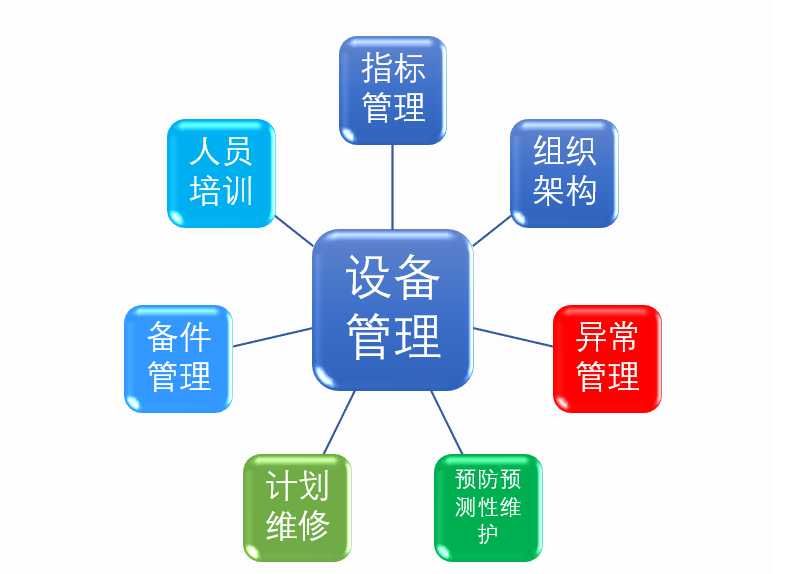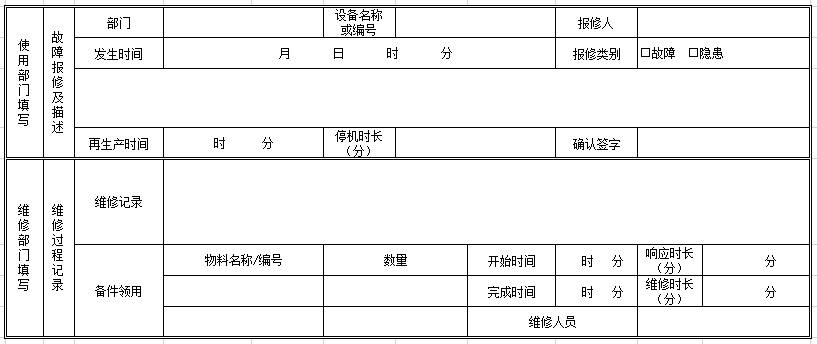Device exception management
Release date:2024-04-10
Equipment management, also known as asset management, is a management method that takes equipment as the research object and pursues the comprehensive efficiency of equipment. It involves the whole life cycle of equipment from planning, design, selection, purchase, installation, acceptance, use, maintenance, repair, transformation, renewal until scrap. Equipment Through scientific management, you can reduce the energy consumption of the equipment, extend its service life, and improve the operating efficiency of the equipment, so as to improve the efficiency of the equipment. The equipment management involved in this paper mainly focuses on the maintenance, repair and renovation of the equipment after use.
Device management consists of seven modules:
Indicator management is the policy of equipment management, and indicator management is a key component to ensure the effective operation and performance optimization of equipment.
Organizational structure is the basis for ensuring device reliability and necessary resource allocation to ensure device performance.
Exception management is a systematic management to correct and maintain the abnormal status of the device.
Preventive predictive maintenance (also known as fixed warranty and complete warranty) is a time-based and abnormal performance based maintenance of equipment components and performance in order to ensure the reliability of equipment.
Scheduled maintenance is a maintenance plan that is developed and implemented in advance to ensure the continuous and efficient operation of equipment during its normal operation.
Spare parts management is insurance, is to prevent safety risks and delivery risks while minimizing the resource occupation of equipment components system management.
Personnel training is a key link to ensure the normal operation of equipment, improve production efficiency, and reduce maintenance costs and abnormal time.

Here we mainly introduce the device exception management module.
An exception is a situation in which a device, system, or process deviates from its normal state or expected behavior during operation. This deviation may be due to internal failure, external interference, operational error, environmental factors, or other unknown causes. An exception usually manifests as performance degradation, functional failure, data errors, alarm signals, or any other phenomenon that does not conform to the normal mode of operation. It may be transient and episodic, or it may be persistent and frequent.
The appearance of an anomaly may mean that the equipment or system needs to be maintained, repaired or replaced to ensure that it is restored to normal operation and to avoid potential failures or accidents. Timely identification, repair, processing, recording, analysis and optimization of anomalies are the key links to ensure the stable operation of equipment and systems, improve production efficiency and ensure safety. The following describes the steps and indicators for device exception management.
1 Procedure for exception management
1.1 Identification and repair
1.1.1 Equipment anomalies are divided into fault type and hidden danger type. Fault type anomalies lead to equipment shutdown and affect delivery. Manufacturing department is the repair subject of fault type anomalies. Hidden danger anomaly is equipment with disease operation, continue to develop will lead to fault anomaly, hidden danger anomaly can be repaired by all departments.
1.1.2 When reporting a device for repair, fill in the detailed information about the device exception, such as the device name, description, occurrence time, reporting personnel, and recovery time. When reporting for equipment repair, it is first reported in the Equipment Management Exception Group, and the Equipment Maintenance Application Form is filled in at the same time. If all the maintenance personnel do not arrive within 5 minutes, the telephone maintenance personnel are required to report for repair. The format of the Equipment Maintenance Application Form used by the company is as follows:

1.2 Exception Handling
1.2.1 After receiving the repair report, the machine repair personnel shall go to the site in time to deal with the abnormal equipment. Before the abnormal equipment is handled, the warning sign shall be hung on the abnormal equipment; After the exception is handled, clean up the maintenance site, organize tools, and track the device status before leaving the site.
1.2.2 Device exception handling includes internal repair and external repair. If the device is abnormal for more than 30 minutes during internal repair, contact device engineers for support. When the equipment is abnormal for more than 60 minutes during internal repair, it is necessary to start the emergency process and negotiate with the supply chain to switch to the production of similar equipment; During external repair, contact the equipment engineer immediately and contact external resources for maintenance.
1.2.3 After the completion of abnormal handling, the maintenance personnel shall fill in the Equipment Maintenance Application Form in time, indicating the maintenance process, maintenance time, access to spare parts information and maintenance personnel.

1.3 Exception Records
1.3.1 After the exception is rectified, the device engineer shall update the Device Management Exception Ledger and Device Resume in time. Collect abnormal data and handling measures, record and analyze them, summarize experiences and lessons, and improve the reliability and stability of equipment operation.
1.3.2 Exception records are case cards. Duplicate faults and hidden devices are identified by one machine and one table, and resources are pooled to solve duplicate problems and hidden devices.

1.4 Anomaly Analysis
1.4.1 Analyze repeated faults, critical faults and hidden dangers of equipment with the security team, and use the analysis ideas of the "Abnormal Rectification List of Quality System" to prevent recurrence.
1.4.2 Long-term solutions to anomalies include inspection (early detection of anomalies), preventive and predictive maintenance (restoration of equipment reliability), and improvement (elimination of design defects).
2 Exception management indicators
You need to periodically analyze the abnormal device data and formulate specific device exception management policies based on the data analysis results. This includes optimizing equipment maintenance plans, improving equipment operation methods, strengthening equipment monitoring and early warning systems and other measures to improve equipment stability and reliability, reduce failure rates, and improve production efficiency. Common statistical indicators of anomalies are as follows:
2.1 Equipment shutdown rate
Indicates the proportion of the downtime due to faults or other reasons to the total operating time. The calculation formula is: downtime = downtime ÷ total running time. A high downtime rate can mean inadequate maintenance or improper operation of the equipment, and it is necessary to promptly investigate the cause and take improvement measures. Companies currently use this metric to assess departmental performance.
2.2 Device failure rate
This is a measure of how often a device fails within a certain period of time. The calculation formula is: failure rate = number of failures ÷ equipment operation frequency. Through regular statistics and comparative analysis of the failure rate, the running status of the equipment can be judged, and the corresponding maintenance strategy can be formulated. Shift rate is also a statistical expression of equipment failure rate.

2.3 Mean Time Between Failures (MTBF)
Refers to the average time between two failures of the equipment, reflecting the average trouble-free working time of the equipment, and the average fault maintenance time is complementary to reflect the health status of the equipment, mainly used to evaluate the reliability of the equipment and eliminate repetitive failures. The number of repeated device management exceptions belongs to this indicator.
2.4 Mean Time to Repair (MTTR)
It refers to the average maintenance time of equipment failure, reflecting the time of a single failure, complementing the average time between failures, reflecting the health status of equipment, and mainly used to evaluate the maintenance skill level of security personnel.
To sum up, equipment exception management is a systematic process, involving multiple links and aspects. Through scientific management measures and data analysis, it can effectively reduce the failure rate of equipment, improve production efficiency, and ensure the normal operation and sustainable development of enterprises. At present, the company is promoting the lean production scheduling of one person and multiple machines, which further improves the reliability requirements of the equipment, and ensures that all personnel will use the equipment exception management system to reduce the number and time of equipment exceptions, and continue to improve the reliability of the equipment.
Last article:Quality control of the village
Next article:Communication skills of Zhengcun corporate culture



